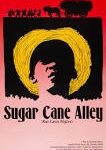
By Risa Gluskin
Cake can make a good analogy.
In an inquiry-style document-based course there is a lot of interpretation going on with very few straight up facts to memorize.
This semester, I keep saying to my CHY4U class, “I hope you’re not waiting for me to stand up here and tell you the answer because it’s not going to happen.” That may be my impatience speaking. Last year, in my super enthusiastic class of participatory history lovers, I didn’t get the feeling anyone was waiting for me to tell them what to think. They were naturally inquisitive and curious.
That gap between last year and this year gives me space to reflect on how much a teacher has to scaffold in order to bring the class to a place where they feel comfortable enough thinking for themselves. It’s sad to say but even in this day and age of ‘modern’ education students are still relatively programmed just to accept information uncritically.
Last year I didn’t think about that issue much. I just took it for granted that all 17-year olds want to think freely.
I have been taking a much more direct approach to “teaching” the skills of history this year. In my first lesson on historiography, I laid it out as a layered cake. The bottom tier (of this class) is the basic facts: who, what, when. The next tier is the historical thinking concepts (HTCs). The last layer is historiography. I really should have added an inquiry layer in there – oops! (There’s a future reflection on why I am so indirect with inquiry yet so direct with HTC.)
Students learned the criteria of “Great Man Theory” and applied it to Galileo Galilei, Matteo Ricci, and La Malinche (the woman who translated for Hernan Cortes during the Spanish conquest of the Aztecs). What made me so happy was that they had such differing interpretations in applying the criteria. In fact, a high point for me in the semester so far was the conclusion to the activity on Galileo. Admittedly, I have a huge love for Galileo. Probably the best history book I’ve ever read was https://www.goodreads.com/book/show/18646.Galileo_s_Daughter“>Dava Sobel’s Galileo’s Daughter. At the end of the class, I had each student come up to the board and write a one word conclusion on Galileo. Results varied from brave to coward with many interesting choices in between. Again, I was so happy to see that they didn’t just take my obvious love for Galileo at face value. My students are beginning to think for themselves.
Last year I didn’t use a cake analogy. The students just seemed naturally accepting of historiography as an angle on history. However, when I think about it deeply and am honest with myself, I didn’t do a great job of structuring their learning about historiography. I’ll write more about that when I get to the next historiography lesson in the course (French Revolution).
For me, scaffolding directly ties into assessment as and for learning: My current students seem to be getting good at HTCs, and I am forcing myself to do more assessment as and for learning in order to determine if this is actually true. Being somewhat old fashioned, non-technical and not having a set of computers in my class, I give each student a paper journal called the “HTC journal.” It is a place to practice the skill of using HTCs, something they will get assessed on over and over. In it are written the kinds of things that students in an e-learning course would deposit in the drop box for teacher and/or peer comment. So far this semester my best use of the HTC journal has been when students had to make a timeline of events leading up to Japan’s seclusion in the 1600s. The timeline was basic but the annotation of it for continuity and change was a nice addition. I gave students a comment on their ability to recognize patterns of continuity and change. Following the return of their journal entry, I set up a template for a timeline with attitude (shows progress and decline as above or below the x axis) on the board. Students then linked the Japanese events together, showing progress and decline. They don’t even know it yet but this was a practice opportunity for the timeline with attitude they will make (assessment OF learning) later in this unit. They are being introduced, step by step, to the idea of progress and decline being different for different groups of people.
Last year, with students being such active participants, I didn’t use the HTC journal nearly enough. I trusted that what they said reflected what they could demonstrate in writing. I thought I knew how they were doing. It turned out I didn’t. As I always say to my teacher candidates from OISE: don’t just go by what they say, you’ve got to see it in writing. Now I need to live up to it.


